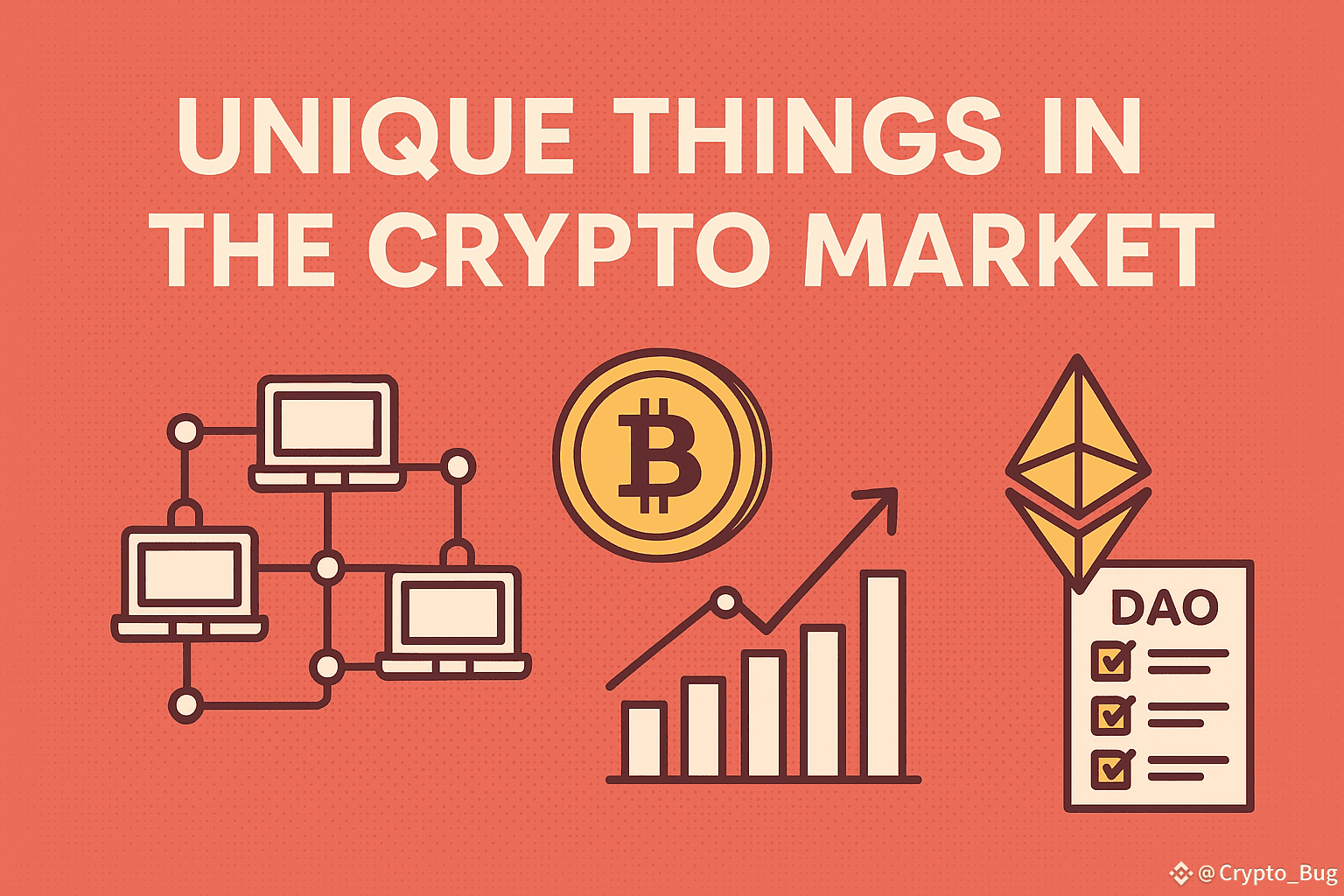The crypto market is a multifaceted ecosystem that diverges significantly from traditional financial markets in terms of technology, structure, and community dynamics. Below is a comprehensive analysis identifying some of its unique characteristics.
1. Decentralization and Trustless Networks
Decentralized Infrastructure:
Unlike conventional markets where central banks and financial intermediaries control transactions, the crypto market operates on decentralized blockchains. This means that transactions are verified by a distributed network of nodes rather than a central authority. The result is a permissionless environment that is resistant to censorship and single points of failure.
Trustless Environment:
The term “trustless” doesn’t imply that there is no trust—it means that trust is embedded in the system’s cryptographic protocols and consensus mechanisms. This allows parties who have never met or don’t know each other to transact securely.
2. Innovation in Tokenomics and Digital Asset Classes
Variety of Digital Assets:
Beyond cryptocurrencies like Bitcoin and Ethereum, the market now includes a range of tokens representing different value propositions. These include:
Utility Tokens: Granting access or usage rights within a platform (e.g., tokens used in decentralized applications).
Security Tokens: Representing traditional assets like stocks or bonds, but issued on blockchain platforms, often subject to evolving regulatory standards.
Non-Fungible Tokens (NFTs): Unique digital assets representing ownership of art, collectibles, or even digital real estate. Their rise has expanded how value is represented and transferred digitally.
Unique Token Economics:
Many projects now experiment with innovative supply mechanisms. Techniques like token burns (reducing supply over time) or staking rewards (incentivizing holding and network participation) can create deflationary or yield-generating properties, making investment in these assets distinct from typical equity or commodity markets.
3. Decentralized Finance (DeFi) Ecosystem
Disintermediation of Financial Services:
One of the most transformative aspects of the crypto market is the development of decentralized finance platforms. DeFi protocols allow for lending, borrowing, yield farming, and liquidity providing—all without traditional banks or credit institutions.
Innovative Financial Instruments:
Products such as flash loans (instant, uncollateralized loans that are repaid within one transaction) and liquidity pools have no direct counterparts in conventional finance. These instruments have spurred new trading strategies and risk management techniques, while also introducing novel regulatory and security challenges.
4. Market Dynamics and Volatility
High Volatility:
#Crypto assets are notorious for their price volatility. While this volatility can be attractive for speculative traders, it also poses challenges for institutional adoption and day-to-day use as a medium of exchange.
24/7 Trading:
Unlike traditional markets that operate on set business hours, crypto exchanges operate around the clock. This continuous trading cycle means that market reactions to global events can be immediate and sustained over various time zones.
Liquidity Variances:
Liquidity is unevenly distributed across the market—from highly liquid assets like Bitcoin and Ethereum to niche altcoins where trading volumes can be thin. This disparity can lead to dramatic price swings in less established tokens.
5. Community and Governance
Community-Driven Projects:
Many crypto projects are launched and maintained by decentralized communities rather than centralized companies. Governance structures often involve distributed autonomous organizations (DAOs), wherein decisions are made democratically by token holders.
Open-Source and Transparent Development:
The underlying code and project roadmaps are often open to public scrutiny, fostering a transparent environment where innovation is driven by community consensus rather than top-down directives.
6. Regulatory and Security Considerations
Evolving Regulatory Landscape:
Because the crypto market bridges technology, finance, and sometimes art (as in the case of NFTs), it faces a complex and rapidly evolving regulatory environment. Regulators across the globe are attempting to balance consumer protection with the encouragement of innovation, which has resulted in a patchwork of rules that vary significantly from one jurisdiction to another.
Security and Risk Management:
The digital nature of crypto assets introduces unique security challenges. Hacks, protocol vulnerabilities, and phishing scams are realities that investors need to consider. This has led to an emerging field of crypto-security and the development of more advanced risk management tools.
7. Global Accessibility and Financial Inclusion
Borderless Transactions:
Crypto is inherently global. Anyone with an internet connection can participate, regardless of their geographic location or access to conventional financial institutions. This inclusivity has opened up financial opportunities for underbanked populations worldwide.
Low Barrier to Entry:
While technical knowledge can initially be a barrier, many platforms strive to simplify user experiences. This democratization of financial tools has the potential to disrupt traditional banking systems and increase global economic participation.
The crypto market stands out not only for its technological innovations but also for its transformational impact on financial structures and global accessibility. Its combination of decentralization, novel financial instruments, community governance, and continuous evolution makes it a unique and dynamic space that continues to challenge the norms of traditional finance. As regulatory frameworks and technological infrastructure mature, the market is likely to witness further innovations and integration into the global financial system, thereby continually redefining what is “unique” in this arena.
